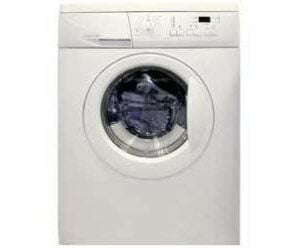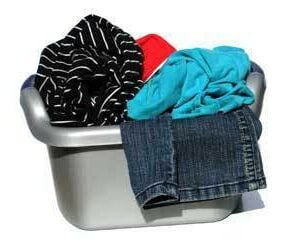Understanding Laundry Starch
When you think of laundry starch, you might think of men from the early 1900s with shirts so stiff that they looked like cardboard cutouts. In those days, clothes were dipped in washing tubs loaded with starch, making them so heavily starched inside and out that the wearer often complained of being itchy and uncomfortable. In the 21st century, laundry starch is applied using spray bottles, making the application of it much lighter, so much so that it is now used to give fabrics more bounce. However, it does still do all of same beneficial tasks of starches from the old days. Starch can make ironing easier, allowing the iron to slide over the surface of the fabric, as well as reduce pilling, guard against stains, reduce static, and stiffen collars.
you think of laundry starch, you might think of men from the early 1900s with shirts so stiff that they looked like cardboard cutouts. In those days, clothes were dipped in washing tubs loaded with starch, making them so heavily starched inside and out that the wearer often complained of being itchy and uncomfortable. In the 21st century, laundry starch is applied using spray bottles, making the application of it much lighter, so much so that it is now used to give fabrics more bounce. However, it does still do all of same beneficial tasks of starches from the old days. Starch can make ironing easier, allowing the iron to slide over the surface of the fabric, as well as reduce pilling, guard against stains, reduce static, and stiffen collars.
Laundry starch is typically thought of as being made from cornstarch, which is derived from corn grain, but it can also be made from wheat or potato starch. These starches are natural and often used in baking, which makes it easy to remember that they should only be used on natural fibers like cotton or wool. Laundry starch won’t soak into any synthetic fibers; instead, it will flake off, making your clothing look dusty.
For synthetics, a product known as “sizing” should be used in place of starch. Sizing is basically modified cellulose, though it often does contain other ingredients like silicone, which helps to prevent it from sticking to an iron. The main difference between starch and sizing in terms of usage is that sizing does not make fabrics crisp. It will do all of the other beneficial starch tasks though.
Making Laundry Starch
- There are several brands of commercial laundry starch available at most supermarkets, but you can also make your own DIY version. It’s as easy as filling a spray bottle with a cup of water and stirring in 1-2 tablespoons of cornstarch. Use only 1 tablespoon for a weaker solution, 2 for a stronger one.
- Although we think of corn as being yellow, cornstarch is actually a bright white, which can make dark clothes look like they’re covered with film. To avoid this, add a cup of black tea to the spray bottle as well. Only use this starch mix on dark clothes though, as the tea will show on lighter fabrics.
- Essential oils can be added for a pleasant scent, but be sure to use an oil that’s clear or only lightly colored for light shades of fabric to avoid getting stains. Some good choices are tea tree oil or peppermint. Only use 2 drops of whatever oil you choose.
Applying Laundry Starch
Steps to Apply the Starch:
- It is a good idea to put the clothes on a surface that can be easily washed as overspray is common. If applying the starch to fabrics on an ironing board that does not have a removable cover, lay a towel over the ironing board.
- Shake your DIY starch before using it to ensure the solution is well-mixed.
- Once you have your starch prepared, lay the clothing items flat and spray it evenly over the fabric. Hold the bottle about 8 inches away from the fabric while spraying.
- Spray on more of the solution if you want crisp clothes, and less if you’re only using the starch for ironing purposes. For ironing, starch should be applied primarily to areas that are wrinkled, as well as places that you want to keep stiff like collars and cuffs.
- Leave the clothes to soak in the starch for as long as needed, which can be anywhere from 15 minutes to several hours, depending on how much spray is used. Letting the fabric soak up the starch is the most important step. If you try to iron the clothes before the starch has fully soaked in, it will cause the iron to stick to the clothes and possibly leave scorch marks.
- Rinse the nozzle of the spray bottle after each use to prevent clogs.
Other Ways to Use Laundry Starch
- An alternative to spraying your clothes with starch is to add it to the final rinse cycle of a wash. This method will disperse the starch throughout the clothes, making them extra crisp. The same recipe above (1 cup water plus 1-2 tablespoons starch) can be used. Pour all of it into the washer during the rinse cycle, then mix it in with your hand or other utensil. For a front-load washer, the starch solution can be poured into a fabric softener dispenser. Dry the laundry as usual, but remove it while it is still slightly damp to iron it.
- If you wear a greasy face cream at night or if you have oily hair, laundry starch can be applied to your pillowcase to prevent stains. Only apply a little so that the fabric does not become stiff and uncomfortable.
- Having trouble threading a needle? Spray some laundry starch on the thread to make it more stiff.
- Apply laundry starch on your canvas shoes immediately after buying or cleaning them to prevent stains.
Additional Tips:
- Cornstarch can be found in the baking aisle of most supermarkets and grocery stores.
- If you like having starched clothes but don’t like starching them yourself, a dry cleaner can do it for you.
- When ironing clothes that have been starched, it is best to turn the iron temperature down to prevent scorching.
- After ironing starched fabrics, wait for the iron to cool, then wipe it with a wet sponge or cloth to clean off any starch residue.
- Clogged starch bottle nozzles should be soaked in lukewarm water for as long as needed to dissolve the clog.
- Laundry starch is a water-based product and therefore should not be used on Dry Clean Only fabrics.
Sources:
- Betty’s Book of Laundry Secrets by Betty Faust and Maria Rodale
- The Cleaning Encyclopedia by Don Aslett
- Natural Green Home Cleaning for Beginners by R. Kishore
- Martha Stewart’s Homekeeping Handbook by Martha Stewart
- Super Natural Home by Beth Greer
- The Naturally Clean Home by Karyn Siegel-Maier
- Cheaper & Better by Nancy Birnes
- Clean & Green by Annie Berthold-Bond
- Vinegar, Duct Tape, Milk Jugs and More by Earl Proulx
- Home Comforts: The Art & Science of Keeping House by Cheryl Mendelson
- Joey Green’s Cleaning Magic by Joey Green
- Haley’s Hints by Graham and Rosemary Haley
- No-Hassle House Cleaning by Christina Spence








Leave a reply